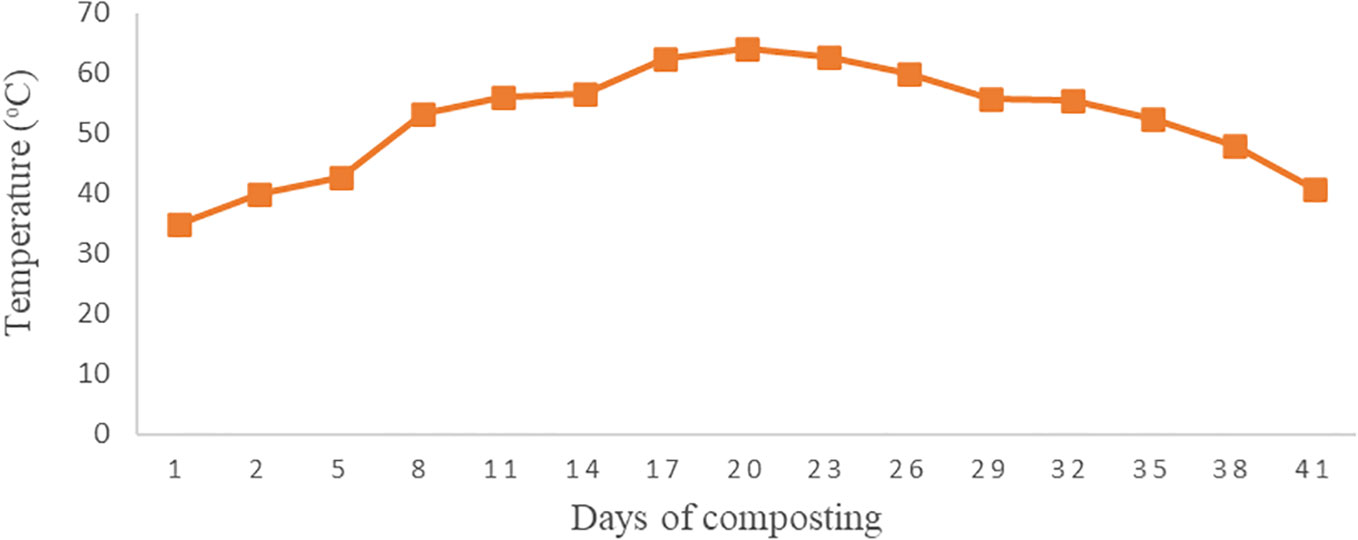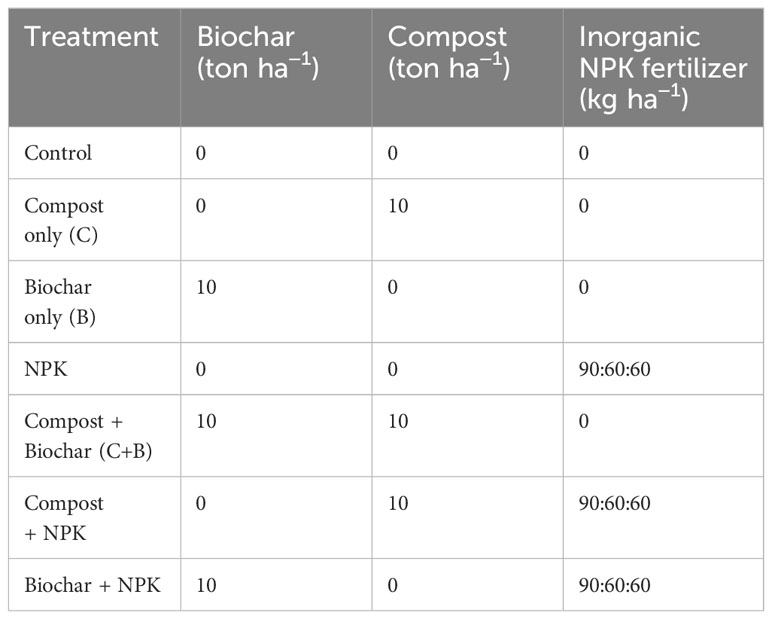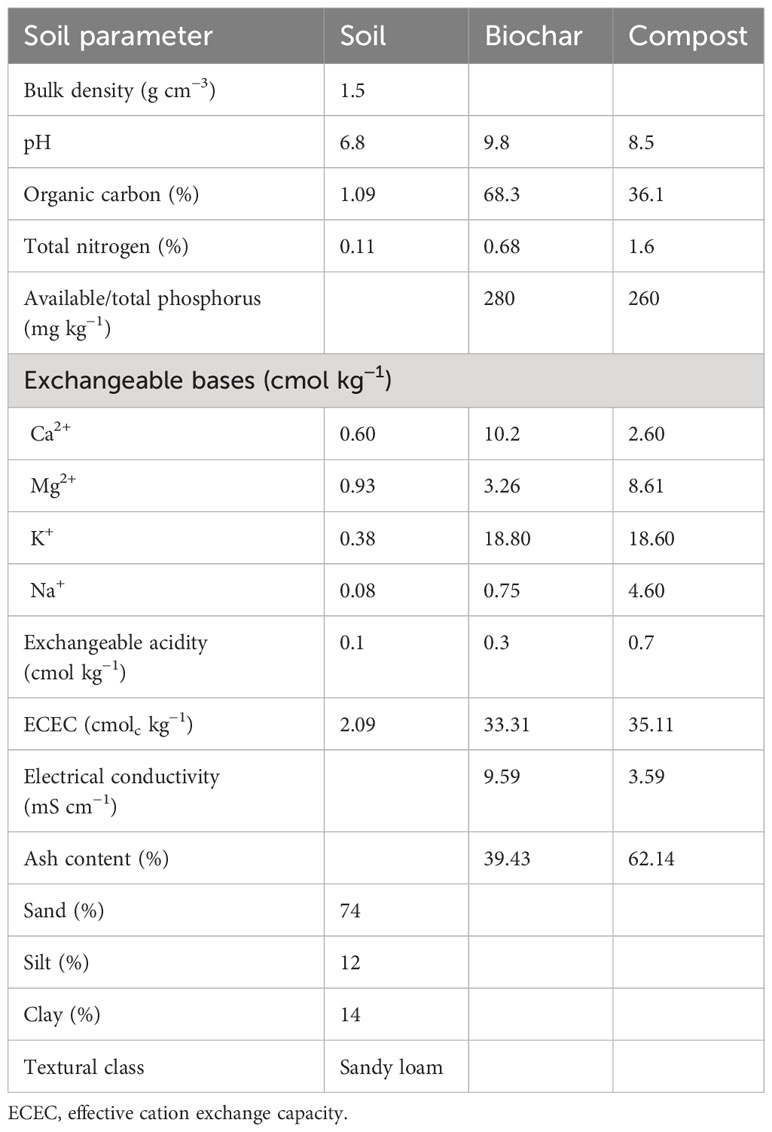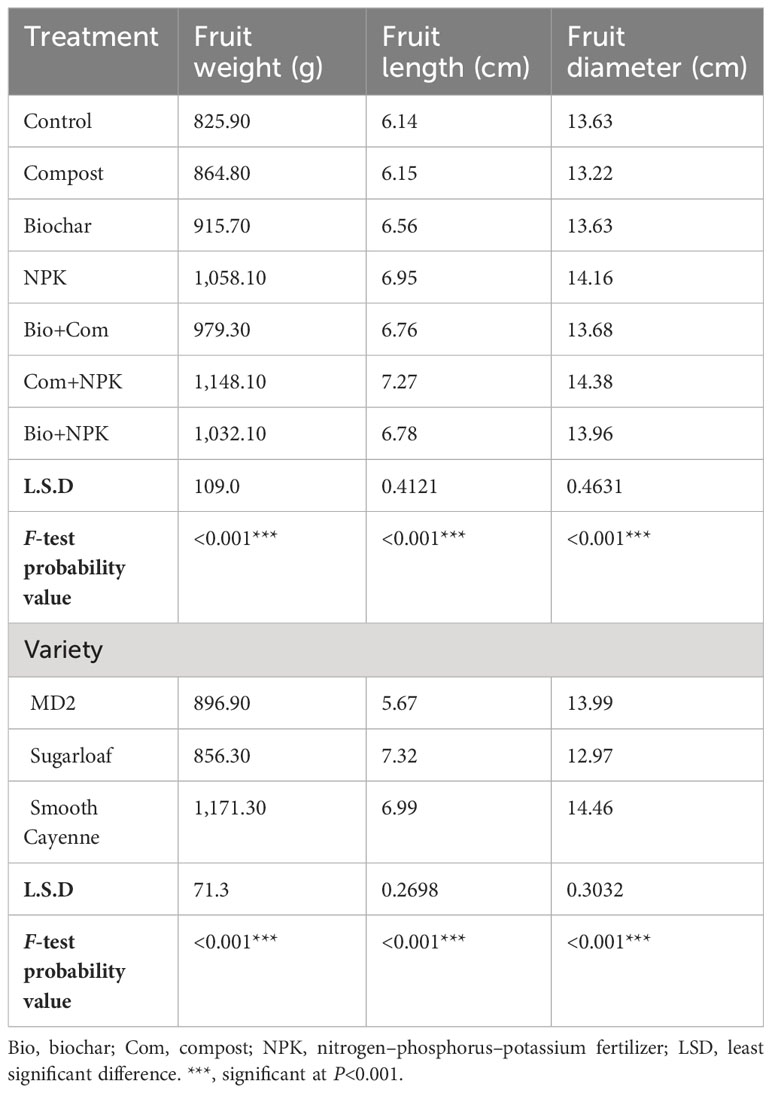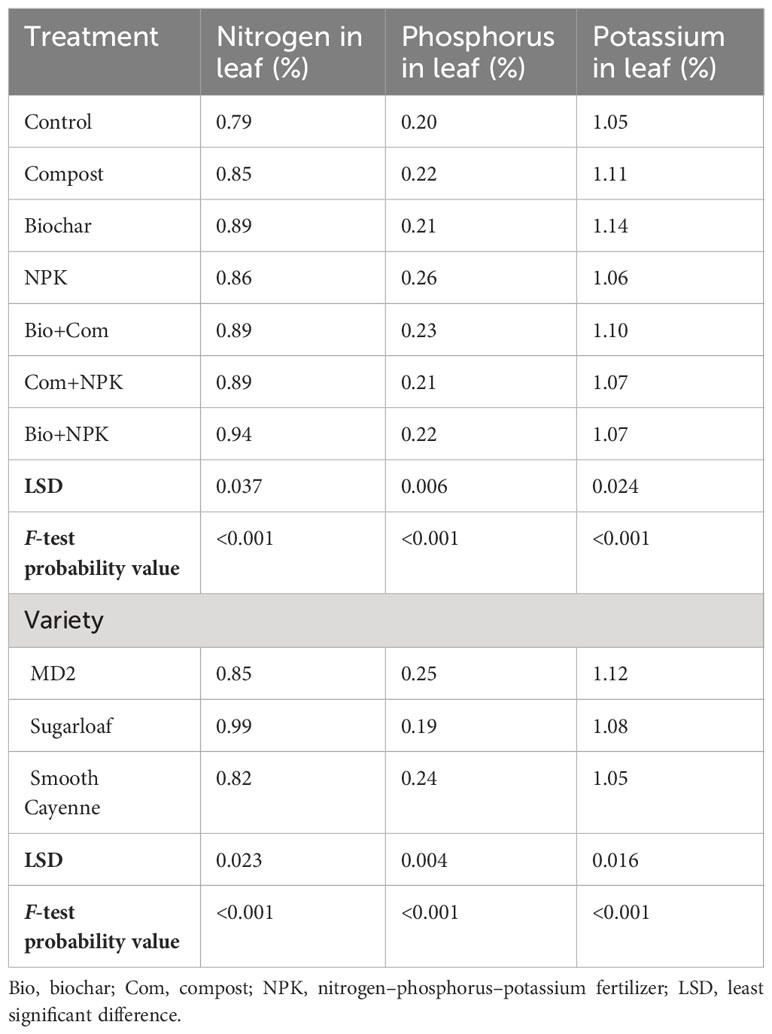- 1Department of Soil Science, School of Agriculture, College of Agriculture and Natural Science, University of Cape Coast, Cape Coast, Ghana
- 2Department of Agricultural Economics and Extension, School of Agriculture, College of Agriculture and Natural Sciences, University of Cape Coast, Cape Coast, Ghana
Introduction: Biochar is one of the commonly used soil amendments for sustainable agriculture. The effect of biochar on crop yields depends on the quality of the biochar, which is influenced by feedstock type and pyrolysis conditions. Sole application of pineapple waste biochar and compost, and their combination has not been rigorously investigated. In this study, we investigated the effects of pineapple waste biochar and compost applied solely or in combination on growth and yield of pineapple on a coastal savanna Acrisol in Ghana.
Methods: The split-plot design with three replications was used, with pineapple varieties as the main plot and fertilizer application rates as the sub-plots.
Results and discussion: The results showed that sole application of biochar and compost or their combination as a soil amendment increased pineapple growth and yield as compared to the unamended soil. Biochar applied in combination with compost/or inorganic NPK (nitrogen, phosphorus, and potassium) fertilizer significantly increased plant height and the number of leaves of pineapple plant, which resulted in improved fruits yield of the three (sugar loaf, MD2 and smooth cayenne) pineapple varieties at maturity over control, sole application of biochar, compost and inorganic NPK fertilizer. The Smooth cayenne variety outperformed MD2 and Sugar loaf variety.
Conclusion: In conclusion, the results revealed that biochar applied solely or in addition to compost or inorganic NPK fertilizer has the capability to enhance soil quality and improve pineapple yield. Application of biochar in combination with compost/or inorganic NPK improves pineapple growth and yield.
Introduction
Pineapple (Ananas comosus) is an important crop that is cultivated in most tropical and subtropical countries. A survey conducted by the Ghana Living Standards showed that approximately 2% of all households in Ghana cultivate pineapple (Williams et al., 2017). In Ghana, suckers are typically used as a planting material for propagation, and harvesting is done between 16 and 18 months after planting (Osei-Kofi et al., 1996). Pineapple production in Ghana is solely rainfed, and smallholder pineapple farmers in Ghana cultivate between 1 and 10 acres of land (MoFA, 2013; Williams et al., 2017). Rainfall and temperature are the two most important climatic factors affecting pineapple production in Ghana. The pineapple-producing regions in Ghana have a temperature range from 20°C to 36°C, with annual rainfall of 600–4,000 mm (MoFA, 2013).
Commercial pineapple production requires continuous nutrient replenishment from organic and/or inorganic sources to support the growth and yield of fruits. In Ghana, access to and the use of inorganic nitrogen, phosphorous, and potassium (NPK) compound fertilizers by smallholder farmers are challenging due to their high cost, unreliability, and limited supply (Mensah and Frimpong, 2018). Continuous and excessive use of inorganic fertilizers may lead to soil acidification, affecting the soil biota and biogeochemical processes and harming the environment. Moreover, the rapid mineralization of organic matter and the resultant nutrient loss through leaching or in gaseous form decrease crop production (Palm et al., 2001). Organic fertilizers have potential for profitable pineapple production as consumer interest in organic pineapple products is rapidly growing. Compost is an organic soil amendment produced from decomposed and recycled organic materials (Adamtey et al., 2009).
Biochar has been recognized as a potential soil amendment globally, but studies addressing the utilization of pineapple waste biochar in Ghanaian pineapple farming systems are limited. The response of different pineapple varieties to sustainable amendments such as biochar and compost has not been adequately explored in the current literature (Aili Hamzah et al., 2021). Varietal differences in terms of growth, nutrient uptake, and yield as a result of these amendments are crucial for tailoring recommendations to specific varieties commonly cultivated in Ghana (Amponsah-Dokua et al., 2022). Despite the capacity of compost to enhance the physicochemical properties of soil, its application under high temperature and moisture conditions can lead to the rapid mineralization and loss of nutrients through leaching and gas emissions (Bernal et al., 1998). Increasing the organic carbon (C) content in soils amended with biochar and compost has been found to increase the soil moisture holding capacity, improve the cation exchange capacity (CEC), and reduce nutrient loss (Mensah and Frimpong, 2018).
Biochar is a stable, recalcitrant organic C compound. It is produced through the thermochemical decomposition of biomass under low or no oxygen condition (Jeffery et al., 2011). The application of biochar in soils increases the soil organic carbon and nutrient contents, decreases the leaching of nutrients, and increases the crop yield (Biederman and Harpole, 2013; Ding et al., 2016). Biochar can sequester carbon from the atmosphere directly into the soil, as the recalcitrant C content of biochar resists decomposition for a long time (Frimpong et al., 2016).
Whereas compost is rich in nutrients, the biochar produced from crop residues is carbon-rich, but N-poor. Therefore, in this study, we hypothesized that biochar applied in combination with compost will improve the soil fertility and physicochemical properties to enhance crop growth and increase yield more than the single application of biochar or compost. Biochar and compost can influence the CEC of the soil. For compost- and biochar-amended soils, cations have been found to be sorbed on biochar particle surfaces, leading to inherent soil nutrients and those from compost being made readily available for plant uptake rather than being leached below the plant root zone (Bernal et al., 1998).
In previous studies, the combined application of biochar and compost enhanced the soil quality, nutrient use efficiency, and structure stability and improved the water holding capacity (Mensah and Frimpong, 2018; Aili Hamzah et al., 2021). Compared with the sole application of biochar or compost, the combined application of biochar and compost had a positive impact on soil nutrients and water holding capacity under field conditions (Bernal et al., 1998; Liu et al., 2012). Similarly, biochar combined with inorganic NPK fertilizer enhanced the growth and yield of crops compared to separate applications (Naeem et al., 2017).
Smallholder farmers along the coastal districts in Ghana have the potential to use biochar, compost, and inorganic fertilizer to produce pineapple commercially. However, no reliable data exist for the extension advisory service to assist them. The mechanism behind biochar application, especially pineapple waste biochar, is not well understood. Hence, the present study investigated the effect of the application of pineapple waste biochar and compost on the growth and yield of pineapple varieties in Ghana.
Materials and methods
The soil type described as Acrisol (FAO, 1980) belongs to the locally classified Asuansi series of the Asuansi–Kumasi/Nta-Ofin compound association. The soils at the experimental site have been developed from granite, giving rise to highly porous gravelly sandy loams over gritty sandy clay soils that are often rich in minerals, especially potassium, if they are not overcropped or severely leached. The climatic conditions of the experimental area are presented in Figures 1, 2.

Figure 1 Mean monthly rainfall of the experimental area during the study (from November 2018 to April 2020).
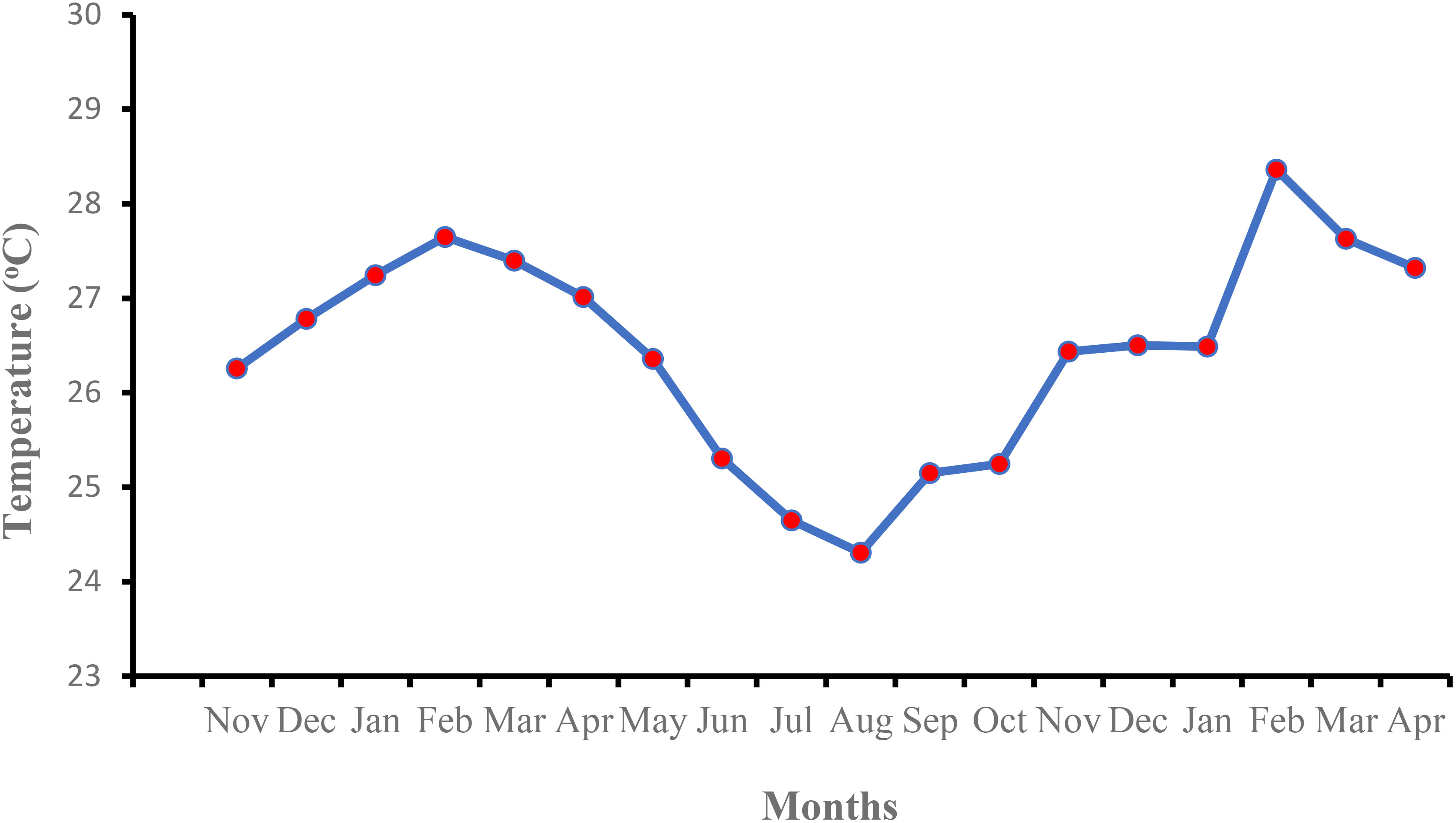
Figure 2 Mean monthly temperature of the experimental area during the study (from November 2018 to April 2020).
Soil samples were collected at a depth of 0–20 cm in a Z pattern before planting and before the amendments were incorporated to determine the initial physicochemical properties of the soil. The samples were bulked, air-dried, sieved through a 2-mm mesh, and kept in a dark room at a temperature of approximately 25°C before the physicochemical analysis. Soil samples that were not disturbed were collected with core samplers for soil bulk density and soil moisture determination.
Soil pH was measured in a 1:2.5 soil/water suspension using the glass electrode of a pH meter (AD 1000) and following the method of Okalebo et al. (2002). The block digester procedure as described by Okalebo et al. (2002) was used to determine the total nitrogen in the soil samples. The soil organic C content was determined using the Walkley–Black method (Rowel, 1994). The Bray P2 method as described by Okalebo et al. (2002) was used to determine the soil available phosphorus. Analysis of soil extraction for exchangeable cations (e.g., Ca, Mg, K, and Na) was performed using the NH4OAc method at pH 7 (Rhoades, 1982). Soil exchangeable acidity was determined with the titration method described by Robertson et al. (1999). The method of Okalebo et al. (2002) for organic matter determination was used to calculate the organic matter and ash contents of pineapple waste biochar and compost.
The total monthly rainfall in the pineapple-growing area in Ghana for the period from November 2018 to April 2020 ranged from 7 to 368 mm (Figure 1). The highest rainfall was recorded in October 2019, the wettest month, with total annual rainfall of just about 370 mm, but with a decreasing 3-mm/year trend.
The lowest mean monthly maximum temperature over the period was recorded in August 2019 (24.2°C), while the highest mean annual maximum temperature was recorded in February 2020 (28.4°C).
Preparation of biochar and compost
The biochar used in this study was produced from pineapple waste (leaves sourced from farmers’ fields and peels from markets and restaurants). The pineapple wastes were chopped and sun-dried over a week to reduce the moisture content.
An Elsa barrel with 1-mm holes was perforated at the bottom to allow airflow, and an L-shaped inward bent (6 cm × 6 cm) placed close to the top sidewalls of the barrel to facilitate the flow of secondary air (Steiner et al., 2018) was used to pyrolyse the pineapple waste into biochar. Approximately 20 kg of the pineapple waste was loaded into the biochar reactor (Elsa barrel) and fire was ignited, with the temperature gradually increased to approximately 550°C during the pyrolysis. After pyrolysis, the biochar produced was ground, sieved through a 2-mm mesh, and stored at 40°C in labeled resealable bags prior to field application.
The Windrow method of composting described by Yvette and Holmer (2000) was used to prepare the compost from freshly chopped pineapple leaves collected from farmers’ fields, 2-month-old poultry manure, and corn stover in a ratio of 60:20:20 (w/w), respectively.
The total C and N contents were analyzed for the pineapple leaves, poultry manure, and corn stover, and then the C/N ratio was calculated before composting them. The pineapple waste, poultry manure, and corn stover were combined in such a ratio that the overall C/N ratio of the compost was within the range of 20–30:1.
During the composting process, the mixture of materials was turned every 3 days in the first 4 weeks and weekly afterwards until the compost matured. It took 1 month and 2 weeks for the compost to mature. The temperature of the compost heap was recorded every time it was turned. Figure 3 presents the graph of the average temperature of the compost at each turning time. The temperature started rising from day 2, with the highest (60°C) around day 20, until it started dropping from day 23. After 6 weeks, the matured compost was air-dried for 2 weeks and a sample then taken to the laboratory for analysis.
Experimental design, treatment application, and planting
The experimental field was cleared with a cutlass, plowed twice, and harrowed with a disc plough to a depth of 20 cm in order to break soil clods. A split-plot design with three replications was used. The pineapple variety (i.e., MD2, Sugarloaf, or Smooth Cayenne) weighed between 291 and 355 g, as all three varieties were grown as the main plot treatment and the soil amendments as the sub-plots. The treatments used in the study were as follows: compost only, biochar only, biochar and compost mixture, inorganic fertilizer (NPK, 15:15:15) only, compost and inorganic NPK fertilizer mixture, biochar and inorganic NPK fertilizer mixture, and a control. A total of 63 ridges (sub-plots) measuring 2.5 m × 0.6 m each was formed and covered with plastic mulch to conserve moisture and control weeds. The amendments and their application rates are presented in Table 1. In this study, we viewed biochar as a soil conditioner that mainly modified the physicochemical and microbial properties of soil, whereas compost and inorganic NPK fertilizers were regarded as amendments that supplied essential plant nutrients. Therefore, in the treatments involving the combined additions of biochar and compost or inorganic fertilizers, the amendments were added in the same rate as that in the treatments that involved single applications of each amendment. In this way, we could elucidate any synergistic effect that occurred between biochar and compost or inorganic NPK fertilizers applied together.
Fruits from the 5 tagged plants were harvested and weighed at the physiological maturity stage [14 months after planting (MAP)]. Data including fresh fruit weight, diameter, and length at the physiological maturity stage (14 MAP) of pineapple were also collected. Approximately 300 g of fresh pineapple from each of the plants was weighed and dried at 60°C for 4 days to determine the dry weight. In addition, 100 g of the fresh fruits was weighed and was used to determine the quality of the pineapple fruit.
Statistical analysis
The data collected were analyzed using GenStat Statistical Software version 12 (VSN International). Differences between the variables were established using correlations. A two-way analysis of variance (ANOVA) was generated at 95% confidence level to determine statistical differences between the treatments (pineapple growth, fruit quality, and yield) and their interaction effects. Fisher’s unprotected least significant difference (LSD) was used for mean comparisons. The F probability value was generated at p ≤ 0.05.
Results
The plant height varied significantly (p < 0.05) among the pineapple varieties and across the treatments (Figure 4). Compost applied in combination with NPK fertilizer recorded the highest plant height. However, this was not significantly different from that of biochar applied in combination with compost and that of the sole application of biochar across the varieties. The control recorded the lowest value of plant height among all the varieties.
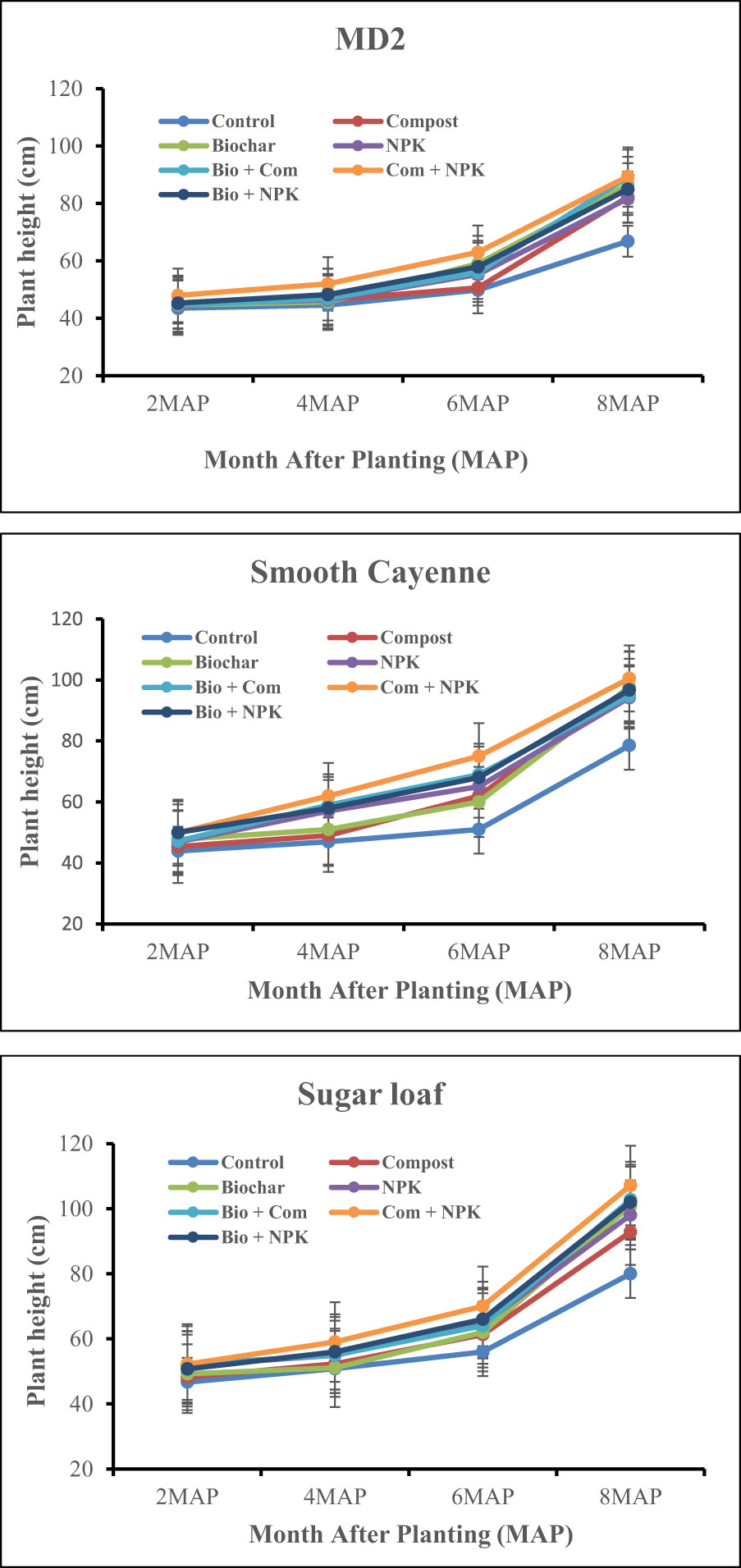
Figure 4 Effects of the application of biochar and/or compost and inorganic NPK (nitrogen, phosphorus, and potassium) fertilizer on the plant height of pineapple prior to flower induction treatment (8 MAP).
The soil used for the experiment was sandy loam with particle size sand, 12 % silt, and 14 % clay with a bulk density of 1.5 g cm-3 and slightly acidic soil pH (Table 2). The total nitrogen (N) and organic carbon contents in the soil were 0.11 and 1.09 respectively. The available phosphorus content in the soil was 15 mg kg-1. Exchangeable calcium (Ca2+), potassium (K+), magnesium (Mg2+), and sodium (Na+) concentrations in the soil were 0.60, 0.38, 0.93 and 0.08 c mol kg-1 (Table 2). The exchangeable acidity in the soil was 0.1 c mol kg-1 whereas the Effective Cation Exchange Capacity (ECEC) was 2.09 c mol kg-1. The pH of the biochar and compost used in the study were 9.8 and 8.5 respectively (Table 2). The total nitrogen (N) contents in the biochar and compost were 0.68 and 1.60 %, respectively while the total organic carbon (TOC) concentrations in the biochar and compost were 68.3 and 36.1 %, respectively. The total P contents in the biochar and compost were 280 and 260 mg kg-1, respectively. Exchangeable calcium (Ca2+), potassium (K+), magnesium (Mg2+), and sodium (Na+) concentrations in the biochar were 10.2, 18.80, 3.26 and 0.75 c mol kg-1 respectively while exchangeable calcium (Ca2+), potassium (K+), magnesium (Mg2+), and sodium (Na+) concentrations in the compost were 2.60, 18.60, 8.61 and 4.60 c mol kg-1 respectively. The exchangeable acidity in the biochar was 0.3 c mol kg-1 but for compost, it was 0.7 c mol kg-1. Effective Cation Exchange Capacity in the biochar and compost were 33.31 and 35.11 c mol kg- 1 respectively. Electrical conductivity for biochar and compost was 9.59 mS cm-1 and 3.59 mS cm-1, respectively. Pineapple biochar had an ash content of 39.43 % while compost had ash content at 62.14 %.
Number of leaves
The number of leaves varied significantly among the three different pineapple varieties and across the treatments (Figure 5). The combined application of biochar and compost recorded the maximum number of leaves, but was not significantly different (p < 0.05) from that of biochar + NPK fertilizer across the varieties.
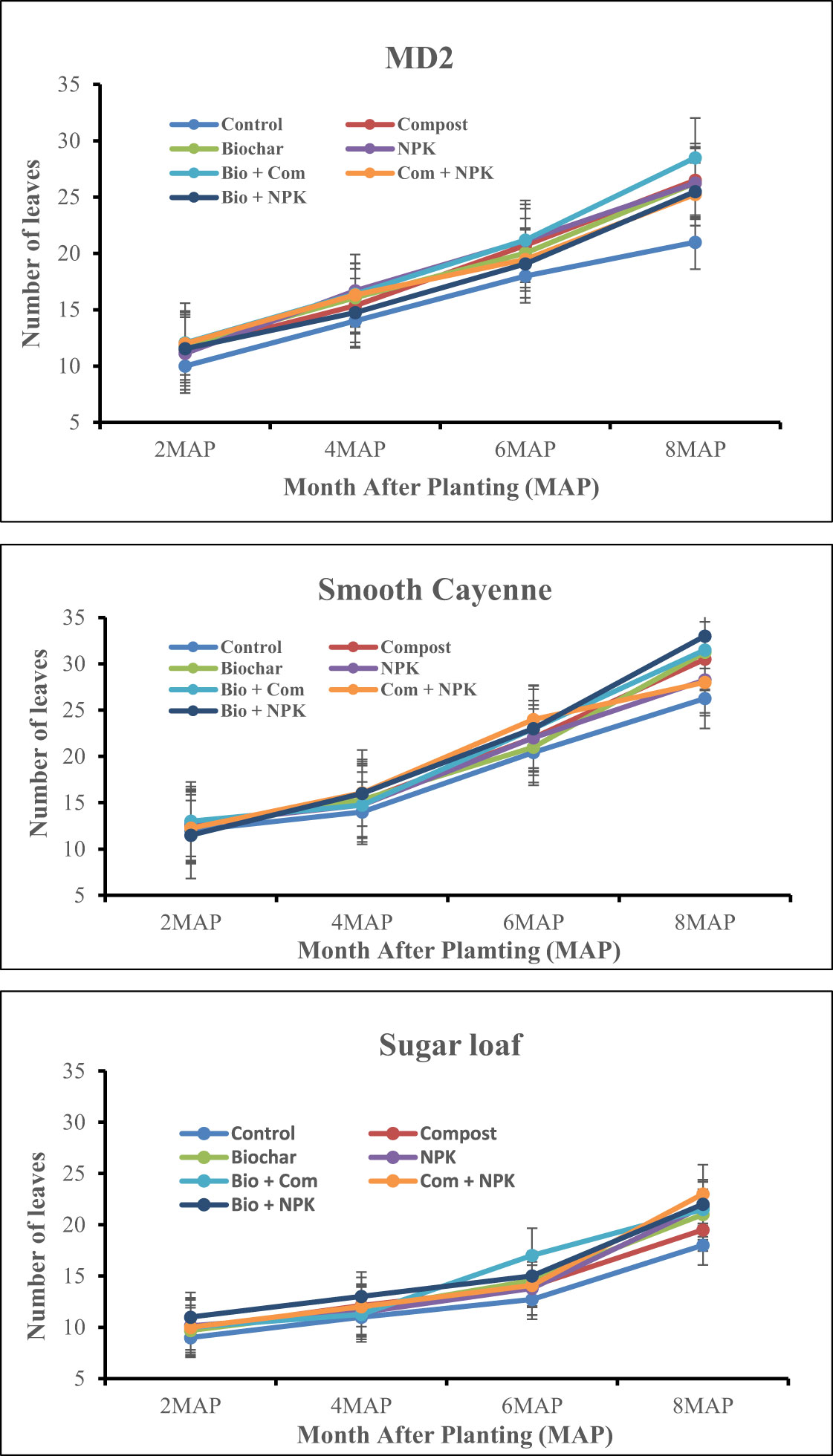
Figure 5 Effect of the application of biochar and/or compost and inorganic NPK (nitrogen, phosphorus, and potassium) fertilizer on the number of leaves of pineapple prior to flower induction treatment (8 MAP).
The control recorded the minimum number of leaves among the three varieties of pineapple (Figure 5).
A significant (p < 0.05) variation was observed among pineapple varieties and fertilizer interactions with respect to plant height prior to flower induction (Table 3). The Sugarloaf variety, which received F5 (biochar + compost), F6 (compost + NPK), and F7 (biochar + NPK), resulted in higher plant height compared to the MD2 and Smooth Cayenne varieties. The highest plant height (107.10 cm) was recorded by the pineapple plant in V2F6, while the lowest plant height was recorded in V1F1. However, F5 (compost + biochar) and F6 (compost + NPK) recorded the highest plant height for the MD2 variety, while F5 (compost + biochar) recorded the highest plant height for the Smooth Cayenne variety.
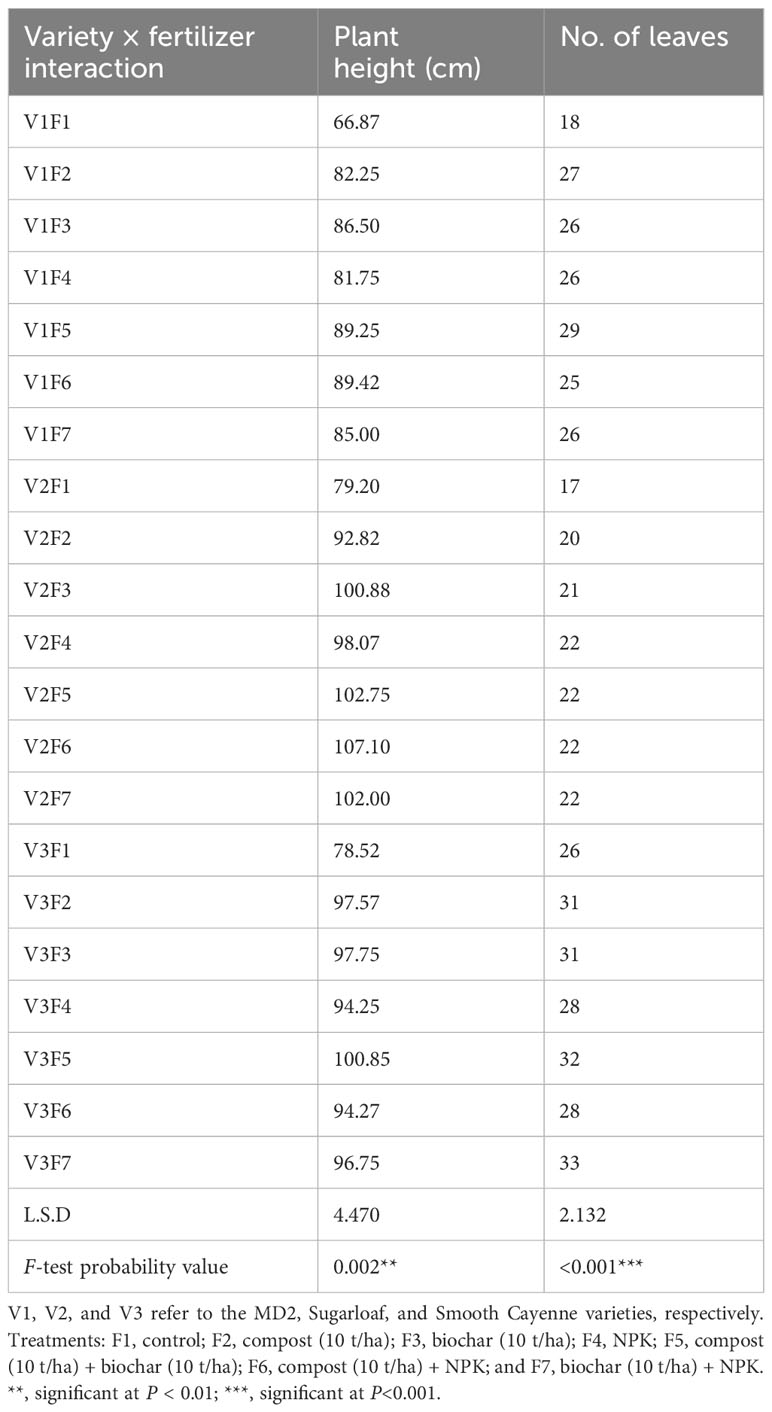
Table 3 Interactive effects of pineapple variety and fertilizer application on plant height and number of leaves.
Significant (p < 0.001) variation was found among the pineapple varieties and fertilizer applications with respect to the number of leaves (Table 3). The combined application of compost and biochar recorded the maximum number of leaves, while the control recorded the minimum number of leaves under the MD2 variety. Sugarloaf, which received F4 (NPK), F5 (compost + biochar), F6 (compost + NPK), and F7 (biochar + NPK) resulted in higher number of leaves (Table 3). The control recorded the least number of leaves for the Sugarloaf variety. The Smooth Cayenne variety grown on F7 (biochar + NPK), F5 (compost + biochar), F3 (biochar), and F2 (compost) recorded higher number of leaves compared to the MD2 and Sugarloaf varieties. The highest number of leaves was recorded by the Smooth Cayenne variety planted on plot amended with pineapple waste biochar and inorganic NPK fertilizer applied together, whereas the lowest number of leaves (n = 17) was recorded by the Sugarloaf variety planted on unamended soil (Table 3).
The effects of the application of the different soil amendments on yield are presented in Table 4. Highly significant differences (p < 0.001) in the effects of the treatments were observed on the fruit weight of pineapple. The combination of inorganic NPK fertilizer and compost recorded the highest fruit weight among all the treatments. The highest pineapple fruit length was observed under the combined application of compost and NPK, which was significantly different (p < 0.001) from the rest of the treatments. The control plot recorded the lowest fruit length.
Differences were observed in the fruit diameter among all the treatments (Table 4). The application of compost with inorganic NPK fertilizer recorded the highest fruit diameter. The sole application of compost recorded the lowest fruit diameter, but was not significantly different from the control and the sole application of biochar (Table 4). Table 4 also provides information on the yield component of pineapple as affected by the varieties. The results presented in Table 4 showed that there was a significant (p < 0.001) difference between the pineapple variety and fruit weight. The Smooth Cayenne pineapple variety had the highest fruit weight (1,171.3 g), which was significantly different from that of the MD2 (896.9 g) and Sugarloaf (856.3 g) varieties. The Sugarloaf variety recorded the highest fruit length (7.32 cm), which was significantly different from that of the MD2 and Smooth Cayenne varieties. The Smooth Cayenne variety recorded the highest fruit diameter (14.46 cm), which was significantly different (p < 0.001) from the fruit diameter of the Sugarloaf and MD2 pineapple varieties.
Pineapple nutrient content
The percentage contents of nitrogen, phosphorus, and potassium in pineapple leaves are presented in Table 5.
Differences were observed in the N, P, and K nutrient contents in pineapple leaves in all the treatments (Table 5). The plot amended with biochar and NPK fertilizer recorded the highest N content (0.94%) in pineapple leaves. It was also observed that treatments with sole biochar, combination of biochar and compost, and combination of NPK and compost had the same N content (0.89%). The control treatment recorded the lowest N content in pineapple leaves. The plot amended with inorganic (NPK) fertilizer recorded the highest P content (0.26%), which was significantly different (p < 0.001) from all other treatments. The control plot recorded the least P content (0.2%) (Table 5). Biochar-amended soil recorded the highest K content (1.14%) in pineapple leaves, while the control had the lowest content of K in pineapple leaves, but which was not significantly different (p > 0.05) from plots amended with NPK, compost + biochar, and biochar + NPK.
The N, P, and K contents in pineapple leaves varied significantly among the three varieties (Table 5). The Sugarloaf pineapple variety recorded the highest N content of 0.99%, followed by the MD2 variety. The lowest percentage N content was recorded by the Smooth Cayenne variety. For the percentage P content, the MD2 pineapple variety recorded the highest (0.25%), while the Sugarloaf variety had the least (0.19%). The MD2 variety had the highest and the Smooth Cayenne variety the lowest K content, recording 1.12% and 1.05%, respectively.
Discussion
Growth performance of pineapple in pineapple waste compost- and/or biochar-amended soils
Plant height
Pineapple plants were relatively taller in the combined biochar and compost and the combined compost and NPK treatments for the MD2, Sugarloaf, and Smooth Cayenne pineapple varieties compared to the other treatments (Figure 4). The results are in accordance with those of Hossain et al. (2019), who reported that the sole application of biochar resulted in a lower plant height compared to the combined application of biochar and inorganic fertilizer. The increased plant height following the co-application of biochar and compost can be attributed to the potential synergistic effect between their combined application on the soil physicochemical properties, such as soil pH, available phosphorus, total organic carbon, exchangeable bases and acidity, effective CEC, and greater soil nutrient availability. All these improved the cell division, plant growth, and physiological performance (Seehausen et al., 2017; Mensah and Frimpong, 2018). The relatively greater height of pineapples grown in the compost- and NPK-amended soil may have been due to the increased nutrient release from the readily soluble inorganic NPK fertilizer (Chen, 2008). According to Zhou et al. (2002), plants grown in soil amended with combined inorganic and organic manure grow quite rapidly due to the enhanced N and P mineralization and release from organic sources. Schulz and Glaser (2012) also confirmed that the application of inorganic NPK fertilizer in addition to biochar increased plant height in tropical soils.
Number of leaves
The number of pineapple leaves differed among varieties across the treatments (Figure 5). The maximum number of leaves obtained in soil amended with biochar and inorganic NPK fertilizer could be attributed to the high nutrient supply from the amendment (Fischer and Glaser, 2012). The combination of inorganic NPK fertilizer and biochar improved the nutrient supply capacity compared to the sole application of biochar (Fischer and Glaser, 2012; Schulz and Glaser, 2012). According to Lehmann et al. (2003) and Oladele et al. (2019), biochar and inorganic fertilizer applied together had a synergistic effect that led to increased plant nutrient uptake, lower nutrient loss, and increased cationic element availability, which is the mechanism also responsible for the increased number of leaves. The comparatively higher number of leaves and leaf development recorded for the combined application of biochar and compost and for the addition of biochar with NPK may have been due to the synergetic effect and the N, P, and K contents in the soil, as reported in other studies (Malézieux and Bartholomew, 2003; Ayoola and Makinde, 2009).
Interactive effect of pineapple varieties and fertilizer application on the growth parameters of pineapple
The interaction between the pineapple variety and the various soil amendments had significant effects on the height of pineapples (Table 3). This result is similar to that obtained by Schulz and Glaser (2012). The longleaf nature of the Sugarloaf variety might have a connection with the highest plant height observed among the three varieties. The highest plant height recorded by the Sugarloaf pineapple variety planted on soil amended with compost and NPK fertilizer (V2F6) could be attributed to the release of nutrients at different times from both organic (compost) and inorganic (NPK fertilizer) sources (Adekiya et al., 2012). The interaction of variety and fertilizer application had a significant effect on the number of leaves of pineapples (Table 3). V3F7 recorded the maximum number of leaves, which could be attributed to the beneficial effect of the inorganic fertilizer (NPK) on pineapple growth (number of leaves). Nitrogen and probably the P and K contents have positive impacts and contribute to vigorous vegetative plant growth (Khan et al., 2008; Islam et al., 2017). The low growth rate of pineapple plants on the control plots could be attributed to the low level of available N and other nutrients required for optimum plant growth (Islam et al., 2017). The results from the current study on the growth parameters (number of leaves) are in agreement with the findings of Arif et al. (2012).
Yield of pineapple varieties
Pineapples planted on plot amended with pineapple compost in addition to inorganic NPK fertilizer recorded the highest pineapple fruit weight among the treatments (Table 4). This was attributed to the presence of N and P. The addition of inorganic fertilizer made the nutrients soluble and readily available for plant growth (Chen, 2008). This result agrees with the findings of Islam et al. (2017) and Fagbenro et al. (2018), who stated that maximum nutrient availability due to the combined application of organic and inorganic fertilizers improved plant nutrient absorption, which in turn contributed to dry matter production and fruit yield.
Similarly, compost applied in addition to NPK fertilizer recorded the highest pineapple fruit length and diameter. This result agrees with the observation made by Ogundare et al. (2015), who reported that the functions of cell division, multiplication, and photosynthesis led to an increase in the size and length of the leaves, fruits, and stems. Moreover, both N and P are necessary for root formation, elongation, and the increase in fruit length, diameter, and fruit yield. The fruit weight, length, and diameter of pineapples varied significantly across the different varieties. The observed inconsistency between the findings for pineapple fruit weight and length could be explained by the variations in soil fertility and the environmental conditions under which the plants were grown (Ogundare et al., 2015).
Pineapple nutrient content
The higher N content of pineapple leaves in the biochar + NPK treatment was probably a result of a reduction in N leaching due to the addition of biochar (Table 5). Similar results were obtained by Tewodros et al. (2018), who reported that biochar supplement reduced the demand for N fertilizer in crop production as a result of a decrease in N leaching, therefore increasing the N use efficiency for crops. The addition of biochar influenced the bioavailability of N and also altered the availability of other nutrients for plant uptake. The nitrogen content in leaves significantly increased with the application of urea. Similar results were observed by Zheng et al. (2013); Basri (2013), and Bashir et al. (2012). The increased P content of the NPK-treated pineapple explains the fact that inorganic fertilizer has a positive effect on plant biomass because mineral fertilizers are easily soluble for plant uptake and utilization (Chen et al., 2009). These findings contradict the observation made by Bashir et al. (2012). The authors obtained increased P content in leaves on soil amended with organic fertilizer. The biochar-treated soil had the highest P content (1.14%) in pineapple leaves (Table 5). These findings are consistent with those of Hossain et al. (2019), who reported a significant increase in K content for plant leaves in biochar-amended soil compared to NPK fertilizer application. According to Darnaudery et al. (2016), the application of biochar can effectively increase the K content in plant tissue.
Conclusion
From the study, biochar and compost amendment and their combination increased the growth of pineapples in terms of plant height and number of leaves of the three pineapple varieties. In addition, the application of biochar in combination with compost or NPK improved the yield of pineapples in terms of fruit weight, fruit diameter, and fruit length. Specifically, pineapple compost applied together with inorganic NPK fertilizer increased the pineapple fruit weight by 39% over the control. In conclusion, these results showed that biochar, applied singly or in addition to compost and inorganic NPK fertilizer, has the capability to enhance the growth of pineapple and improve its yield, but biochar applied in combination with compost or inorganic NPK fertilizer outperformed the sole application of biochar, compost, and inorganic NPK fertilizer. The Smooth Cayenne variety performed better than MD2 and Sugarloaf in terms of fruit weight and length.
Data availability statement
The raw data supporting the conclusions of this article will be made available by the authors, without undue reservation.
Author contributions
EH: Data curation, Methodology, Software, Writing – original draft, Writing – review & editing. KF: Conceptualization, Funding acquisition, Investigation, Supervision, Validation, Visualization, Writing – review & editing. FA: Conceptualization, Funding acquisition, Investigation, Project administration, Resources, Validation, Writing – review & editing. KA: Formal Analysis, Methodology, Validation, Visualization, Writing – review & editing.
Funding
The author(s) declare financial support was received for the research, authorship, and/or publication of this article. This study was supported by RUFORUM MasterCard Foundation with grant number RU/2018/CARP+/06.
Conflict of interest
The authors declare that the research was conducted in the absence of any commercial or financial relationships that could be construed as a potential conflict of interest.
Publisher’s note
All claims expressed in this article are solely those of the authors and do not necessarily represent those of their affiliated organizations, or those of the publisher, the editors and the reviewers. Any product that may be evaluated in this article, or claim that may be made by its manufacturer, is not guaranteed or endorsed by the publisher.
References
Adamtey N., Cofie O., Ofosu-Budu G. K., Danso S. K. A., Forster D. (2009). “Production and storage of N-enriched co-compost”. Waste Manage. 29 (9), 2429–2436. doi: 10.1016/j.wasman.2009.04.014
Adekiya A. O., Ojeniyi S. O., Agbede M. T. (2012). Poultry manure effects on soil properties, leaf nutrient status, growth, and yield of cocoyam in a tropical Alfisol. Nigerian J. Soil Sci. 22 (2), 30–39.
Aili Hamzah A. F., Hamzah M. H., Che Man H., Jamali N. S., Siajam S. I., Ismail M. H. (2021). Recent updates on the conversion of pineapple waste (Ananas comosus) to value-added products, future perspectives and challenges. Agronomy 11, 2221. doi: 10.3390/agronomy11112221
Amponsah-Dokua B., Daymond A., Robinson S., Atuah L., Tom Sizmur T. (2022). Improving soil health and closing the yield gap of cocoa production in Ghana–A review. Sci. Afr. 15, e01075. doi: 10.1016/j.sciaf.2021.e01075
Arif M., Ali A., Umair M., Munsif F., Saleem M., Ayub G. (2012). Effect of biochar, FYM and mineral nitrogen alone and in combination on yield components of maize. Sarhad J. Agric. 289 (2), 191–195.
Bashir M. K., Steven S., Pandit. S. (2012). The determinants of rural household food security in the Punjab, Pakistan: an econometric analysis (Crawley, Australia: Working paper 1203, School of Agricultural and Resource Economics, University of Western Australia). Available at: http://ageconsearch.umn.edu/bitstream/122526/2/working%20paper%201203.pdf.
Basri (2013). Effects of mixed organic and inorganic fertilizers application on soil properties and the growth of kenaf (hibiscus cannabinus l.) cultivated on bris soils. Am. J. Appl. Sci. 10 (12), 1586–1597.
Bernal M. P., Sanchez-Monedero M. A., Paredes C., Roig A. (1998). “Carbon mineralization from organic wastes at different composting stages during them incubation with soil”. Agric. Ecosyst. Environ. 69 (3), 175–189. doi: 10.1016/S0167-8809(98)00106-6
Biederman L. A., Harpole W. S. (2013). “Biochar and its effects on plant productivity and nutrient cycling: A meta-analysis”. GCB Bioenergy 5 (2), 202–214. doi: 10.1111/gcbb.12037
Chen J. H. (2008). Department of Soil and Environmental Sciences, National Chung Hsing University 250 Kuo-Kuang Road, Taichung (Taiwan ROC).
Chen N. J., Paull R. E., Chen C. C., Saradhuldhat P. (2009). Pineapple Production for Quality and Postharvest Handling. Acta Horticulturae 822, 253–260. doi: 10.17660/ActaHortic.2009.822.3
Darnaudery M., Fournier P., Léchaudel M. (2016). Low-input pineapple crops with high quality fruit: promising impacts of locally integrated and organic fertilization compared to chemical fertilizers. Experimental Agriculture, 54 (2), 286–302. doi: 10.1017/S0014479716000284
Ding N., Melloni L., Zhang H., Tian X., Poeppel D. (2016). “Cortical tracking of hierarchical linguistic structures in connected speech”. Nat. Neurosci. 19 (1), 158–164. doi: 10.1038/nn.4186
Fagbenro J. A., Oshunsanya S. O., Oyeleye B., Aduayi E. A. (2018). Effect of two biochar types and inorganic fertilizer on soil chemical properties and growth of maize (Zea mays l.). Int. Educ. Sci. Res. J. 2 (4), 43–50.
Fischer D., Glaser B. (2012). “Synergisms between compost and biochar for sustainable soil amelioration,” in Management of organic Waste. Ed. Kumar S. E. (China: In Tech, Shanghai), 167–198.
Frimpong K. A., Amoakwah E., Osei B. A., Arthur E. (2016). “Changes in soil chemical properties and lettuce yield response following incorporation of biochar and cow dung to highly weathered acidic soils,”. J. Organic Agric. Environ. 4 (1), 28–39.
Hossain M., Piash I. M., Perveen Z. (2019). Effect of biochar and fertilizer application on the growth and nutrient accumulation of rice and vegetable in two contrast soils. Acta Sci. Agric. 3 (3), 74–83.
Islam M., Islam S., Akter A., Rahman M., Nandwani D. (2017). Effect of organic and inorganic fertilizers on soil properties and the growth, yield and quality of tomato in Mymensingh, Bangladesh. Agriculture 7 (3), 18. doi: 10.3390/agriculture7030018
Jeffery S., Verheijen F. G. A., van der Velde M., Bastos A. C. (2011). “A quantitative review of the effects of biochar application to soils on crop productivity using metaanalysis”. Agric. Ecosyst. Environ. 144 (2), 175–187. doi: 10.1016/j.agee.2011.08.015
Khan H. Z., Malik M. A., Saleem M. F. (2008). Effect of rate and source of inorganic material on the production potential of spring maize (Zea mays L.). Pak. J. Agric. Sci. 45 (1), 40–43.
Lehmann J., da Silva J. P., Steiner C., Nehls T., Zech W., Glaser B. (2003). Nutrient availability and leaching in an archaeological Anthrosol and a Ferralsol of the Central Amazon basin: fertilizer, manure and charcoal amendments. Plant Soil 249 (2), 343–357. doi: 10.1023/A:1022833116184
Liu J., Schulz H., Brandl S., Miehtke H., Huwe B., Glaser B. (2012). Short- term effect of biochar and compost on soil fertility and water status of a Dystric Cambisol in NE Germany under field conditions. J. Plant Nutr. Soil Sci. 175 (5), 698–707. doi: 10.1002/jpln.201100172
Malézieux E., Bartholomew D. P. (2003). Plant nutrition. In: Bartholomew D. P., Paul R. E., Rohrbach K. G.. (Eds). The pineapple: botany, production and uses. Honolulu: CAB, p. 143–165.
Mensah K. M., Frimpong A. K. (2018). “Biochar and/or compost applications improve soil properties, growth, and yield of maize grown in acidic rainforest and coastal savannah soils in Ghana”. Int. J. Agron. 2018, 1–8. doi: 10.1155/2018/6837404
MoFA (2013). Pineapple production manual. Export Marketing and Quality Awareness Project (EMQAP) (Ministry of Food and Agriculture).
Naeem M. A., Khalid M., Aon M., Abbas G., Amjad M., Murtaza B., et al. (2017). Combined application of biochar with compost and fertilizer improves soil properties and grain yield of maize. J. Plant Nutr. 41 (1), 112–122.
Ogundare S. K., Babatunde I. J., Etukudo O. O. (2015). Response of tomato variety (Roma F) yield to different mulch materials and staking in Kabba, Kogi State, Nigeria. J. Agric. Studies 3 (2), 61–70. doi: 10.5296/jas.v3i2.7568
Okalebo J. R., Gathua W. K., Woomer L. P. (2002). Laboratory Methods of Soil and Plant Analysis: A Working Manual (2nd ed.) (Kenya: Nairobi).
Oladele S., Adeyemo A., Awodun M., Ajayi A., Fasina A. (2019). Effects of biochar and nitrogen fertilizer on soil physicochemical properties, nitrogen use efficiency and upland rice (Oryza sativa) yield grown on an Alfisol in Southwestern Nigeria. Int. J. Recycling Organic Waste Agric. 8 (1), 295–308. doi: 10.1007/s40093-019-0251-0
Osei-Kofi F., Amoatey H. M., Lokko Y. (1996). “Improvement of pineapple (Ananas comosus (L.) Merr.) using biotechnology and mutation breeding techniques,” in Proceedings of the IAEA/FAO international symposium on in vitro techniques for selection of radiation induced mutants adapted to adverse environmental conditions, vol. 1996. (Vienna: IAEA), 23–27.
Palm C. A., Gachengo C. N., Delve R. J., Cadisch G., Giller K. E. (2001). “Organic inputs for soil fertility management in tropical agroecosystems: application of an organic resource database”. Agric. Ecosyst. Environ. 83 (1-2), 27–42. doi: 10.1016/S0167-8809(00)00267-X
Rhoades J. D. (1982). “Cation exchange capacity,” in Methods of soil analysis. Part 2. Chemical and Microbiological Properties. Eds. Page A. L., Miller R. H., Keeney D. R. (Madison, Wisconsin: American Society of Agronomy, Inc. Soil Science Society of America. Inc), pp: 149–157.
Robertson G. P., Blair J. M., Groffman P. M., Harris D., Holland E., Nadelhoffer K., et al. (1999). “Soil carbon and nitrogen availability; nitrogen mineralization, nitrification and soil respiration potentials,” in Standard Soil Methods for Long-Team Ecological Research. Eds. Robertson G. P., Bledesoe C. S., Coleman D. C., Sollins P. (New York: Oxford University Press).
Rowel D. L. (1994). “Analysis methods and applications,” in Soil Science (Berlin, New York: SpringerVerlag).
Schulz H., Glaser B. (2012). Effects of biochar compared to organic and inorganic fertilizers on soil quality and plant growth in a greenhouse experiment. J. Plant Nutr. Soil Sci. 175 (3), 410–422. doi: 10.1002/jpln.201100143
Seehausen M., Gale N., Dranga S., Hudson V., Liu N., Michener J., et al. (2017). Is there a positive synergistic effect of biochar and compost soil amendments on plant growth and physiological performance? Agronomy 7 (1), 13. doi: 10.3390/agronomy7010013
Steiner C., Bellwood-Howard I., Häring V., Tonkudor K., Addai F., Atiah K., et al. (2018). Participatory trials of on-farm biochar production and use in Tamale, Ghana. Agron. Sustain. Dev. 38 (1), 12. doi: 10.1007/s13593-017-0486-y
Tewodros M., Mesfin S., Getachew W., Ashenafi A., Neim S. (2018). Effect of Inorganic N and P Fertilizers on Fruit Yield and Yield Components of Pineapple (Annanas comosus MERR L. Var. Smooth cayanne) at Jimma, Southwest Ethiopia. Agrotechnology 7, 178.
Williams P. A., Crespo O., Atkinson C. J., Essegbey G. O. (2017). Impact of climate variability on pineapple production in Ghana. Agric. Food Secur. 6, 26. doi: 10.1186/s40066-017-0104-x
Yvette B. G., Holmer R. J. (2000). Composting of Organic Wastes: A Main Component for Successful Integrated Solid Waste Management in Philippine Cities.
Zheng H., Wang Z., Deng X., Herbert S., Xing B. (2013). Impacts of adding biochar on nitrogen retention and bioavailability in agricultural soil. Geoderma 206 (1), 32–39. doi: 10.1016/j.geoderma.2013.04.018
Keywords: pineapple waste, biochar, compost, pineapple varieties, and crop yield
Citation: Hanyabui E, Frimpong KA, Annor-Frempong F and Atiah K (2024) Effect of pineapple waste biochar and compost application on the growth and yield of pineapple varieties in Ghana. Front. Agron. 6:1331377. doi: 10.3389/fagro.2024.1331377
Received: 02 November 2023; Accepted: 08 January 2024;
Published: 19 February 2024.
Edited by:
Mohammad Bagher Hassanpouraghdam, University of Maragheh, IranReviewed by:
Amit Anil Shahane, Central Agricultural University, IndiaPatrick Nyambo, University of Fort Hare, South Africa
Copyright © 2024 Hanyabui, Frimpong, Annor-Frempong and Atiah. This is an open-access article distributed under the terms of the Creative Commons Attribution License (CC BY). The use, distribution or reproduction in other forums is permitted, provided the original author(s) and the copyright owner(s) are credited and that the original publication in this journal is cited, in accordance with accepted academic practice. No use, distribution or reproduction is permitted which does not comply with these terms.
*Correspondence: Emmanuel Hanyabui, ZW1tYW51ZWwuaGFueWFidWlAc3R1LnVjYy5lZHUuZ2g=
 Emmanuel Hanyabui
Emmanuel Hanyabui Kwame Agyei Frimpong1
Kwame Agyei Frimpong1